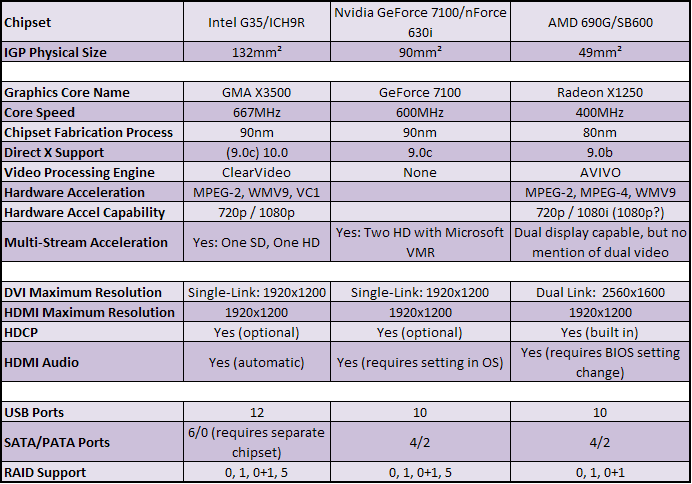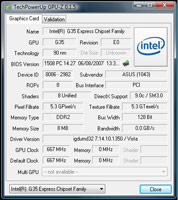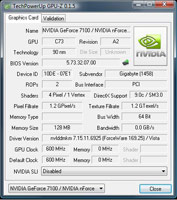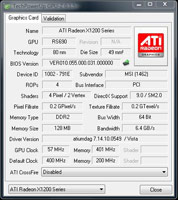Home Theatre PC Motherboard Shootout
February 5, 2008 | 11:55

Integrated Graphics Comparison
As Intel's second unified shader graphics processor, the Intel GMA X3500 with its eight unified shader units is over 2.5x the size of AMDs older 690G which is based on X700 technology. However, AMD has fabricated its chipset on a finer process than both Nvidia and Intel, making it smaller and cooler.Despite being just over 1.8x the size, Nvidia manages to cram both the north and south bridges onto a single die, although there's no Pure Video element in this chipset. Should we take AMD's SB600 as well into the equation the AMD pair uses less silicon at 85mm², but uses more board real estate because both have to be housed in separate packages with interconnecting traces.
The Nvidia GeForce 7100 offers the no video decoding acceleration support – only the GeForce 7050PV for AMD processors does this, although Nvidia will introduce its updated GeForce 8200 IGP for AMD processors in the near future. The Intel G35 will accelerate everything except for h.264 – it does VC-1 but it's the lesser supported of the two competing disk authoring formats.
AMD's 690G can accelerate MPEG-4 (DivX/Xvid) playback but not VC-1 or h.264 which is only supported in Avivo HD and the dedicated UVD that was introduced with the Radeon HD 2000-series graphics products after the AMD 690G was introduced. After an update last summer, the AMD 690G can also fully accelerate playback for up to 1080p content and Intel also claims up to full 1080p-HD support with its G35, however you'll have to wait for the next generation Nvidia IGP for the same commitment.

The Nvidia GeForce 7100 and Intel G35 only cater to a single link DVI connection, but this still provides up to 1920x1200 output (the typical resolution on a 24" TFT) which is also more than enough for full HD at 1080p. In addition, all of them offer HDCP support, however Nvidia and Intel don't integrate it into the silicon – in the case of the Gigabyte board a simple external crypto ROM is installed, but the Asus board requires a Silicon Image Sil1392 chipset used for digital TDMS as well as HDCP. This puts the emphasis on the board maker to swallow the cost or leave it out (no doubt dubbed "the provision of choice" by chipset manufacturer) and only the AMD 690G includes everything in-silicon.
The relative video processing engines claim to do funky things with the video: AMD's list includes:
- Motion adaptive 3D comb filtering
- Automatic colour and gain control
- Hardware noise reduction and edge enhancements
- Vector adaptive de-interlacing
- Video scaling
- Spatial and temporal dithering.
- Advanced de-interlacing
- Directional motion detection
- Noise reduction
- Film mode detection
- ProcAmp colour control
- Noise removal
- Advanced motion adaptive de-interlacing
- Video scaling
- Inverse telecine (2:2 and 3:2 pull-down correction)
- Colour temperature and "bad edit" correction
Expect the next generation of chipsets, which will be shown off in a month’s time at CeBIT, to include further video processing and acceleration technologies that we're now used to seeing only on discrete graphics cards. We’ve already had a quick look at what GeForce 8200 has at its disposal in our Hybrid SLI preview, while both AMD and Intel also have new integrated graphics chipsets coming too.

MSI MPG Velox 100R Chassis Review
October 14 2021 | 15:04











Want to comment? Please log in.